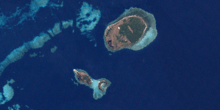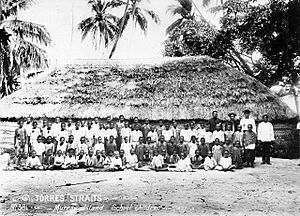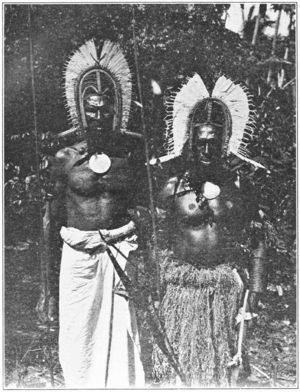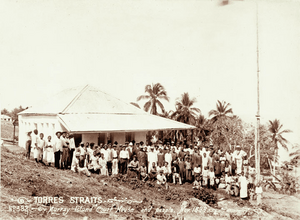Murray Island, Queensland facts for kids
|
Native name:
Mer
|
|
|---|---|

A satellite image of Murray Island
|
|

A map of the Torres Strait Islands showing Mer in the northeastern waters of Torres Strait
|
|
| Geography | |
| Location | Northern Australia |
| Coordinates | 9°55′S 144°3′E / 9.917°S 144.050°E |
| Archipelago | Torres Strait Islands |
| Adjacent bodies of water | Torres Strait |
| Total islands | 3 |
| Major islands | 1 |
| Area | 4.29 km2 (1.66 sq mi) |
| Highest elevation | 234 m (768 ft) |
| Highest point | Gelam Paser |
| Administration | |
|
Australia
|
|
| State | Queensland |
| Regional Authority | Torres Strait Regional Authority |
| Local Government Area | Torres Strait Island Region |
| Demographics | |
| Population | 485 (2006 census) |
| Murray Island Queensland |
|
|---|---|
| Population | 406 (2021 census) |
| Postcode(s) | 4875 |
| Time zone | AEST (UTC+10:00) |
| LGA(s) | Torres Strait Island Region |
Murray Island, also called Mer Island, is a special place in the Torres Strait Island Region, Queensland, Australia. It's one of the islands in the Murray Island Group in the Torres Strait. The main town is on the island's northwest side.
This island was formed by a volcano and is the most eastern island in the Torres Strait. It's just north of the amazing Great Barrier Reef. Its local name, Mer, comes from the native Meriam language. In 2021, about 406 people lived here.
The island is home to the Melanesian Meriam people. There are eight main tribes on Mer: Komet, Zagareb, Meuram, Magaram, Geuram, Peibri, Meriam-Samsep, and Piadram/Dauer. The way the island is organized follows old laws about land and ownership.
| Top - 0-9 A B C D E F G H I J K L M N O P Q R S T U V W X Y Z |
Geography of Murray Island
Murray Island is in the eastern part of the Torres Strait. It's a basaltic island, meaning it was formed from an extinct volcano. This volcano was last active over a million years ago. It formed when a huge tectonic plate moved over a hot spot deep in the Earth.
The island rises to a flat area about 80 meters (262 feet) above sea level. The highest point is Gelam Paser, which is 230 meters (755 feet) high. This point is at the western end of the old volcano crater. The island has rich, red soil and is covered in thick plants. It has a tropical climate with a wet season and a dry season.
Murray Island is one of three islands in the Murray Islands group. The other two islands are Daua Island (called Dowar) and Waier Island (called Waier).
History of Mer Island
Early History and First Settlers
People have lived on Murray Island for about 2,800 years. The first settlers were Papuo-Austronesians. They brought farming and pot-making skills with them. In the 1800s, people from Torres Strait started having regular contact with Europeans, Asians, and other visitors. This happened because the Torres Strait became a busy sea route between the Indian Ocean and the Pacific Ocean.
The people of the Torres Strait, including the Meriam people, were known as strong warriors and skilled sailors. They sometimes fought with other tribes or with European ships passing through the area. A famous story involves Jack Ireland, a young cabin boy. He survived a shipwreck in 1834 and spent time on Mer Island before being rescued.
In 1836, a large ceremonial mask was found on nearby Aureed Island. This mask was made of turtle shells and had many skulls around it. Some of these skulls belonged to the crew of the Charles Eaton ship. They had been killed after their ship was wrecked. The mask is now in the Australian Museum.
European Settlement and Changes (1872 onwards)
Missionaries, mostly from Polynesian islands, began to settle on Murray Island in 1872. The London Missionary Society started a school there. The Queensland Government officially took control of the islands in 1879. The Australian artist Tom Roberts visited the island in 1892. He saw a special night dance and later painted it.
In 1936, the Islanders were unhappy with how their wages and boats were managed by the government. They went on a strike to gain more control. This led to the Torres Strait Islander Act 1939. This law gave Islanders more power over their own lives and set up local governments on each island.
When World War II began in 1941, over 700 Islanders volunteered to protect the Torres Strait. They formed a group called the Torres Strait Light Infantry Battalion. After the war, many Islanders moved to mainland Australia as jobs in the pearling industry became scarce. In the 1980s, some Islanders called for more independence from Australia. This was because the government was not providing enough basic services on the island.
Murray Island's most famous resident was Eddie Mabo. He was a trade unionist who decided to sue the Queensland Government. He wanted to get back ownership of his family's land. This land had been taken away by the British colonial powers using a legal idea called terra nullius, which meant "nobody's land".
His case went all the way to Australia's highest court. On June 3, 1992, the court made a landmark decision known as the "Mabo decision". This decision finally recognized the native title rights of Indigenous Australians to their land. This decision changed Australian law forever. Eddie Mabo passed away a few months before the decision was made. After his grave was damaged, he was reburied on Murray Island. Islanders held a traditional ceremony for him, like for a king.
People and Culture
In 2016, Mer Island had a population of 450 people. By 2021, the population was 406 people.
The people of Mer Island still follow their traditional culture. However, modern things like consumer goods, television, and travel are also influencing their way of life. Even so, song and dance are still a very important part of island life. These are shown during celebrations like Mabo Day, Coming of the Light, and other cultural events. In 2007, the skulls of five Islander tribesmen were returned to Australia from a museum in Glasgow. They had been kept there for over 100 years.
The artist Ricardo Idagi was born on Murray Island. He won a major award at the Western Australian Indigenous Art Awards in 2009.
Language of Mer Island
The people of Murray Island speak Torres Strait Creole and Meriam. Meriam is a language from the Trans–New Guinea family. It is related to languages like Bini, Wipi, and Gizrra. Even though it's different from Kalaw Lagaw Ya, spoken in the Central and Western Torres Strait Islands, the two languages share about 40% of their words. Torres Strait English is also spoken as a second language.
How Murray Island is Governed
Murray Island is run by the Community Council. This council is in charge of things like roads, water, housing, and community events. The Community Council is a very important part of daily life. The older people, or elders, in the community are highly respected. They also have a big influence on island life.
Queensland's control over the islands expanded from just 3 miles offshore to 60 miles. This brought almost all of the Torres Strait islands under Queensland's rule. Before this, only islands within three miles of the coast were controlled by Queensland. Murray Island was not officially claimed until 1879. In that year, Britain officially added the island to Queensland. This was done to protect British people and their property. It also helped control the Torres Strait, which was an important sea route to India. Britain also wanted to control the fishing and pearling industries.
Britain gave all control of the Torres Strait islands to Queensland without making any treaties. This was to stop other countries from claiming the region.
Notable People from Mer Island
- Eddie Mabo, a famous campaigner for land rights.
- Gail Mabo, an artist and Eddie's daughter.






